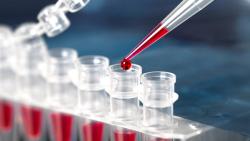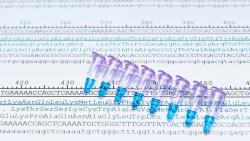
OR WAIT null SECS
- About Us
- Advertise
- Editorial Information
- Contact Us
- Do Not Sell My Personal Information
- Privacy Policy
- Terms and Conditions
© 2024 MJH Life Sciences™ and BioPharm International. All rights reserved.
Improving Oligonucleotide Analysis
Oligonucleotides, which are classified as both small molecules and biomolecules, pose unique analytical challenges. High-resolution mass spectrometry is becoming a method of choice for their development.
Oligonucleotides (polymeric sequences of RNA and DNA) are becoming increasingly vital research tools due to their ability to inhibit genes or to function as aptamers to interact with protein targets. Over the next six years, demand for oligonucleotides in areas that include gene therapies is expected to grow by 20.6% per year to reach US$3697 million by 2026 (1). One of the ways in which oligonucleotides work is by targeting RNA function at the cellular level, where specific malfunctioning genes can be targeted, manipulated, and/or modulated (2). Robust, accurate analytical characterization of oligonucleotides is necessary in order to confirm their identity, and to determine purity, quality, and strength. A wide range of oligonucleotides are available for clinical and research use, with specific tools ranging in size, chemical modifications, and degree of conjugation.
The diversity of oligonucleotides has made their analysis challenging, necessitating the development of new analytical techniques that can address the varied tasks in a high-throughput environment. This article highlights mass spectrometry (MS) techniques that are improving the analysis of oligonucleotides and enabling high-throughput analysis. Oligonucleotides are commonly produced through synÂthetic solid-phase chemical synthesis, and precise analytical characterization is required to confirm identity, determine safety, and to identify and quantify contaminants. Numerous impurities must be identified and removed, and post-synÂthesis processing must be monitored.
Due to the complexity and diversity of oligonucleotides in clinical development, for example, differences in identity, structure, biological potency, and physiochemical properties, a range of analytical approaches has been developed. These methods include liquid chromatography–mass spectrometry (LC–MS), high-performance liquid chromatography (HPLC), nuclear magnetic resonance (NMR), Fourier transform infrared spectroscopy (FTIR), and polyacrylamide gel electrophoresis (PAGE).
Oligonucleotide analysis is an essential part of drug development, registration, and quality control (QC), so methods that are capable of separating and identifying impurities must be established.
The limited accuracy and speed of electrophoretic techniques such as PAGE have led the industry towards HPLC for the separation of oligonucleotides for analysis. However, oligonucleotides with similar molecular weights present a challenge for HPLC, particularly those with higher molecular weights, so development of robust MS methods to characterize and quantitate oligonucleotides and synthesis contaminants has become a key focus. HPLC-MS is superior due to its comÂbination of high mass accuracy, high throughput, reproducibility, robustness, sensitivity and precision that the other analytical techniques lack.
Determining molecular weight and confirming the nucleotide sequence of an oligonucleotide are fundamental criteria for establishing the molecule’s identity, which is a regulatory requirement. Oligonucleotide synthesis is a complex process that requires more than 100 sequential chemical reactions to make a single 25-base sequence (3), and the quality of each synthesized oligonucleotide must be evaluated prior to use to ensure that the correct sequence was made and that purity meets regulatory standards.
Numerous methods can be applied to obtain this information, and developments in high-resolution MS in particular have provided a viable alternative to other methods such as PAGE, offering significantly better accuracy for the determination of both mass and sequence of oligonucleotides. PAGE is a subjective method of analysis and can only give average mass information whereas MS is a high-resolution technique and high-resolution accurate mass (HRAM) mass spectrometers can provide monoisotopic mass information of the oligonucleotides.
Oligonucleotides are considered neither small nor large molecules, leading to many regulatory challenges and a lack of guidance. The variety in their structure (i.e., whether they are single or double-stranded), molecular weight, molecular size, and number of negative charges all affect the molecular interaction with targeted tissue. These factors have led to disagreement between regulatory agencies, such as the European Medicine Agency (EMA) and the US FDA, in how to classify these species. Specifically, FDA considers oligonucleotides as small molecules, but the EMA uses a cenÂtralized procedure required for drug products manufactured using biotechnology processes (4). Consequently, there is no official FDA guidance for QC expectations. However, the agency has issued some guidance on the analÂysis of oligonucleotides with respect to identity, purity, quality, and strength, as part of the chemistry, manufacturing, and controls (CMC) regulatory process (5).In addition to their regulatory ambiguities, oligonucleotides can be challenging to use in gene therapies because their diverse modes of action can complicate their delivery in vivo. For one thing, oligonucleotide delivery is a two-fold process. First, the oligoÂnucleotide must be transported to the tissue of therapeutic interest with miniÂmized exposure to other tissues. Then it must then be delivered to the correct intracellular compartment in order to function. In order for an oligonucleotide to down regulate gene expression, it must penetrate into the targeted cells. Systemic oligonucleotide delivery has been accomplished in rodent models, but their action becomes localized to the liver (6), and high oligonucleotide accumulation is also observed in the kidney and other organs such as the spleen, heart, pancreas, and the brain, which show far lower concentrations.
Single-stranded DNA and RNA oligonucleotides also have other properties that complicate drug development. For example, they can be degraded by nucleases when introduced into biological systems; other potential problems include poor uptake through cell membranes, unfavorable bio-distribution and pharmacokinetic properties, and sub-optimal binding affinity for complementary sequences (7). Fortunately, challenging delivery issues are being addressed (e.g., through approaches such as chemical modification of the oligonucleotide itself; implementation of lipid or polymeric nanocarriers; and linking oligonucleotides to receptor-targeting agents such as carbohydrates, peptides, or aptamers).
As a result, significant contributions have been made at a therapeutic and clinical level, applying tailored solutions based on the characteristics of the molecules involved. Even with the most efficient synthesis, however, it is crucial that synthesized oligonucleotides be evaluated for quality before they are used in molecular biology applications.
Analyzing with MS
MS techniques, including electrospray ionization (ESI) and matrix-assisted laser desorption/ionization (MALDI), are being used to obtain accurate molecular weight, sequence confirmation, and characterize impurities in both high- and low-throughput modes. These powerful technologies can be applied across the biopharmaceutical pipeline, from oligonucleotide develÂopment through to QC.
High-resolution MS generates accurate data to support characterization requirements. A mass spectrum can be a useful QC tool to help verify that a custom oligonucleotide was synthesized correctly and, more specifically, that it has the expected molecular weight based upon the requested base sequence. When considering intact mass, low-resolution instrumentation can only be used to obtain the average molecular weight. In contrast, high-resolution mass spectrometry enables the determination of accurate mass. This method is based on obtaining negative ion spectra of the oligonucleotide followed by interpretation of the spectra. This is typically done using deconvolution software algorithms where all the multiply charged species are recalculated into the singly charged form.
The accuracy of these measurements is typically less than 5 ppm, and, as such, the mass can be used to help establish the empirical formula of the molecule, which is in turn used to postulate or confirm structure (8). In addition to determining accurate molecular weight, MS provides information about the sequence and/or structure of the biomolecules. When comparing the use of MALDI and ESI for the analysis of oligonucleotides, itis important to consider the type of mass analyzer used because that will determine the limits of resolution and mass range. Analyses of LC-separated and ionized samples can be accomplished through the use of different mass analyzers. These can be divided into two main groups based on their working methods: beam type analyzers that continually scan ions (e.g., timeÂ-of-flight [TOF] and quadrupole) and trap-based analyzers that capture ions of interest for a specific time to acquire mass spectrum.
A quadrupole mass analyzer acts as a variable mass filter that separates ionized species using only electrical fields generated by a direct current and superimposed radio-frequency potential. Ions are then introduced in a path parallel to that of a quadrupole rod and only ions of a particular mass and charge can pass through, with all non-confirming ions filtered out. The majority of quadrupole TOF (QTOF) MS systems have tandem capabilities, so that precursor ions that have been separated by mass-to-charge ratio in the first stage (MS1) can be selected and then separated and detected in the second stage (MS2) as fragments (product ions) in the QTOF. Precursor ions are selected in the quadrupole and sent to the collision cell for fragmentation, and the generated product ions are then detected by TOF MS.
MALDI-TOF offers high sensitivity for oligonucleotides, is relatively easy to use, and is well-suited to a high-throughput laboratory environment. The method is also reasonably tolerant of the presence of salts, buffers, and other additives. Accurate measureÂment by MALDI-TOF is limited to oligonucleotides less than 50 bases in length. Longer oligonucleotides tend to ionize poorly or “fly” in a MALDI– TOF instrument.
Alternatively, ESI technology maintains high mass accuracy, resolution, and sensitivity over a range of lengths (20–120 bases), but has a reduced throughput compared to MALDI–TOF. MALDI–TOF is amenable to high throughput since the sample/matrix mixture is spotted on a metal grid which is then analyzed in the instrument, with data typically acquired in a fraction of a second. In ESI–MS, the sample is introduced via a syringe or injected by an HPLC system, and data acquisition takes place in a matter of several minutes, depending on the complexity of the samples.
This requires closer attention to be given to sample cleanliness, which is important in ESI as the instrument is more susceptible to contamination. Generally, ESI is most effective in synÂtheses involving more than 50 bases.
The future of analysis
Oligonucleotides continue to present a growing opportunity, as well as an analytical challenge, to biopharmaceutical developers. MS techniques such as ESI-QTOF and MALDI-TOF can be used for ultra-high-resolution analysis of oligonucleotides to achieve sensitive detection with enhanced speed and data quality. Current data analysis software such as Bruker Daltronics’ BioPharma Compass 3.1 is available that can work with both high resolution ESI-QTOF and MALDI-TOF data.
Advances in these technologies promise to facilitate the ongoing development of more efficient oligonucleotide therapies, improving methods of delivery as well as the QC pipeline. Oligonucleotides show low stability against nuclease in vivo, but progress in the development of chemically modified nucleic acids and technology has allowed the development of a number of stable and effective candidate products. In 2016 Nusinersen (Spinraza), an antisense oligonucleotide drug for spinal muscular atrophy, was approved as an oligonucleotide therapeutic for infants (9). Current techniques and studies are paving the way for future analysis of polymeric sequences of nucleotides. Coupled with novel data-analytical software, MS is supporting the development of new oligonucleotide therapeutics.
References
1. Zion Market Research, “Oligonucleotide Synthesis Market Expected to Reach USD 3,697 Million By 2026, Globally,” Press Release, January 2019.
2. B2B Labs, “Oligonucleotides: Opportunities, Pipeline and Challenges,” www.b2blabs.com, Dec. 12, 2016.
3. Integrated DNA Technologies, “Technical Report: Mass Spectrometry Analysis of Oligonucleotide Syntheses,” Video, 2017.
4. B2B Labs, Oligonucleotides: Opportunities, Pipeline and Challenges, www.b2blabs.com, June 2016.
5. FDA, “CMC Regulatory Considerations for Oligonucleotide Drug Products: FDA Perspective,” Presentation, 2017.
6. D. Argyle et al., “Molecular/Targeted Therapy of Cancer,” in Small Animal Clinical Oncology (Fourth Edition), ed. S. J. Withrow, D. M. Vail, (Withrow & MacEwen, 2007).
7. X. Shen, D. R Corey, Nucleic Acids Research, 46(4) (2018).
8. R. Houghton, Chromatography Today, (March 2011).
9. C. Stein and D. Castanotto, Molecular Therapy, 25 (5) (2017).
About the Author
Anjali Alving, anjali.alving@bruker.com, is a senior scientist for pharmaceuticals and biopharmaceuticals at Bruker Daltonics.
Article Details
BioPharm International
Vol. 32, No. 9
September 2019
Pages: 40–43
Citation
When referring to this article, please cite it as A. Alving, “Improving Oligonucleotide Analysis,” BioPharm International 32 (9) 2019.

 Download Issue: BioPharm International-09-01-2019
Download Issue: BioPharm International-09-01-2019

